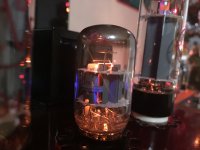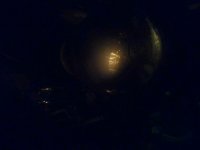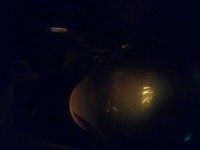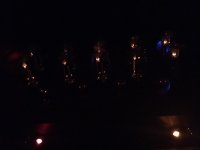My electro-harmonix box with lamp at the valve base does look good.Dont know why they did it Cosmetics OR better visibility on a darkend stage????????
some nice glow from my amplifiers
I looked at your page and must say you have one of the nicest systems I’ve ever seen
Do you build amps?
thanks yes i build amplifiersI looked at your page and must say you have one of the nicest systems I’ve ever seen
Do you build amps?
LE SON DES TUBES
An open plate structure and blue fluorescence, nice.One more
Ceramic RF power devices give blue fluorescence from the Al2O3, at high powers. Based on experience with ceramic 4CX250B's. But the forced air cooling would be too noisy for audio alas!
Perhaps an EM84 indicator tube could be pressed into service as audio amp?
Perhaps an EM84 indicator tube could be pressed into service as audio amp?
One more
Looks like 6BN11 or one of the related Compactrons (6J11, 6BW11, 8CB11, 8BQ11, 6AR11 )
led backlight...Here’s my cheap little tube amp
View attachment 774553View attachment 774554View attachment 774555View attachment 774556

-------------------------------------
literally any mesh plates is the goal.
I'll never understand why they put LED's (even blue ones 😱) under a tube's base 🙄…
Best regards!
I used to think it was cheesy, but now I kind of like it.
Looks like 6BN11 or one of the related Compactrons (6J11, 6BW11, 8CB11, 8BQ11, 6AR11 )
Yes, 8CB11
6BN11 has the same internals, just different pinout.
I've gone all tube and all SS in the past with varying results. After quite a bit of experimenting the best combination for me seems to be tube pre-amp and SS power amp. Even flea power SS amps like the Amp Camp produce very satisfactory results with a tube pre-amp in front of it.
I agree. The current ongoing project🙄, is a SS design but the discovery of a couple of TRF radio sets, one of the sets was too deteriorated to restore, but all the valves tested good. (The one used as the detector measured a bit less emission but still works) This set me off with the need to experiment.😀
The amp is sectional and so the VAS circuit was replaced by a substitute, a voltage conveyor to drive the grid and a floating filiment source, a CCS plate load, but all is actually direct coupled and so the DC is servoed. This makes the valves interchangeable so slight variations do not effect the output. OPS is HEC variation, 100+W. Triode is bias 120V @ constant 2.5mA, +/-30Vp output. Sound is, quite wonderful, listening to the genius of Beethoven.🙂
Anytime you pour sand into an amp, it is good measure to have competent fault protection, to switch off the amp if it malfunctions.
 .
. Although apparently they made many of the 201A back then, I've read that they are kind of rare. ( I do treat them like fragile eggs😀) I switched one of them out, the sticker on this one is stamped Aug 18, '27.

I look at a component from the POV of what can I do with it. I find that these hollow things do amplify quite well.

Attachments
Last edited:
I probably cant see something, but the heating doesnt look that uniform. The fins are hottest, is this weher the beam is focussed? I make the assumption it's a beam pentode. I'd expect the cooling fins to glow the least, if they are going there job and radiating heat away from the source.
Is it usual for pentodes to red plate on both sides of the anode, even if that red glow is not a spot? (as a beam pentode may show) such as my photo in post 50
Is it usual for pentodes to red plate on both sides of the anode, even if that red glow is not a spot? (as a beam pentode may show) such as my photo in post 50
Last edited:
I probably cant see something, but the heating doesnt look that uniform. The fins are hottest, is this weher the beam is focussed? I make the assumption it's a beam pentode. I'd expect the cooling fins to glow the least, if they are going there job and radiating heat away from the source.
Is it usual for pentodes to red plate on both sides of the anode, even if that red glow is not a spot? (as a beam pentode may show) such as my photo in post 50
Do you mean your 6P30B filaments? They look nice. 🙂
Once I saw a wonderful firework in 6S19P tube, when it's grid got fried with blue sparks all the way up like a ladder, between anode plates. 🙂
I could not take a picture then. But I made a video of an amp with 6S19P, Gu-17, and 6F12P tubes all glowing pretty nice.
Constellation-T-2 in the darkness
I probably cant see something, but the heating doesnt look that uniform. The fins are hottest, is this weher the beam is focussed? I make the assumption it's a beam pentode. I'd expect the cooling fins to glow the least, if they are going there job and radiating heat away from the source.
Is it usual for pentodes to red plate on both sides of the anode, even if that red glow is not a spot? (as a beam pentode may show) such as my photo in post 50
Once I tested a batch of 30pcs of 6P45S (beam tetrode)for uniform anode heating.
Most had overheating redness on one side of the anode only
Only one piece scored with both sides red.
😀
Wavebourn and 50AE,
Wavebourn, I am speaking of beam pentodes in general, but also it is relevant to my use of 6P30BR.
Being less experienced than many, I thought a beam pentode operated in one dimension, like a light house, emitting beams front and back.
I didn't realise I was correct, until I researched the devices further.
The relevance to 6P30BR is that it has dual anodes.
I felt stupid that I assumed these anodes were identical, but are they?
Last night I felt even more stupid, as the possibility occurred to me that 6P30BR may just have 2 connections to a single anode. Checking today (astounded I didn't try earlier) each anode is indeed isolated.
50AE,
That summarises my points exactly (how did you know?)
Try as I might, ALL my examples of 6P30BR have some red plating on one anode, and NEVER the other.
Are both anodes rated the same?
It certainly doesnt appear so.
Thank you both for your answers
Wavebourn, I am speaking of beam pentodes in general, but also it is relevant to my use of 6P30BR.
Being less experienced than many, I thought a beam pentode operated in one dimension, like a light house, emitting beams front and back.
I didn't realise I was correct, until I researched the devices further.
The relevance to 6P30BR is that it has dual anodes.
I felt stupid that I assumed these anodes were identical, but are they?
Last night I felt even more stupid, as the possibility occurred to me that 6P30BR may just have 2 connections to a single anode. Checking today (astounded I didn't try earlier) each anode is indeed isolated.
50AE,
That summarises my points exactly (how did you know?)
Try as I might, ALL my examples of 6P30BR have some red plating on one anode, and NEVER the other.
Are both anodes rated the same?
It certainly doesnt appear so.
Thank you both for your answers
^ nice! Interesting that some show fluorescence and others not, is that one particular type of tube? I.e the 12SN7
Kyuss fan, by any chance? Guessing from your username.
Kyuss fan, by any chance? Guessing from your username.
What tubes give good glow? Answer, all of them......you just have to ignore a few rules......
Note that the 833A's are specified to run with a bit of red glow from the plates. The filaments in the 813's light up the room.
The other tubes are not seen in normal operation, I might have turned the knobs past 11.
Note that the 833A's are specified to run with a bit of red glow from the plates. The filaments in the 813's light up the room.
The other tubes are not seen in normal operation, I might have turned the knobs past 11.
Attachments
-
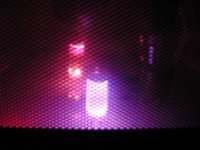 TUBE_COLOR.JPG136.7 KB · Views: 138
TUBE_COLOR.JPG136.7 KB · Views: 138 -
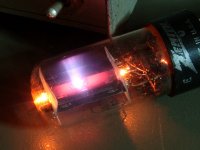 BluRay.jpg103.5 KB · Views: 128
BluRay.jpg103.5 KB · Views: 128 -
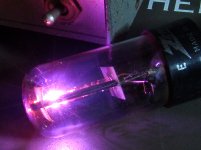 Arcing.jpg106.6 KB · Views: 133
Arcing.jpg106.6 KB · Views: 133 -
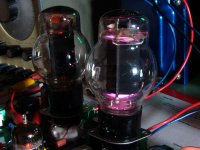 GassyGlow.jpg259.8 KB · Views: 152
GassyGlow.jpg259.8 KB · Views: 152 -
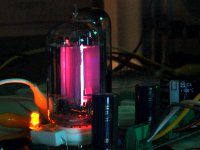 Syl_40W.jpg339.7 KB · Views: 158
Syl_40W.jpg339.7 KB · Views: 158 -
 6BQ6GA.jpg228.4 KB · Views: 159
6BQ6GA.jpg228.4 KB · Views: 159 -
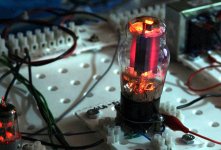 6L6_maxed.jpg137.7 KB · Views: 164
6L6_maxed.jpg137.7 KB · Views: 164 -
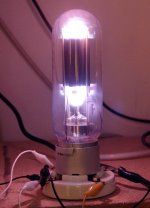 Blue_211.jpg172.8 KB · Views: 147
Blue_211.jpg172.8 KB · Views: 147 -
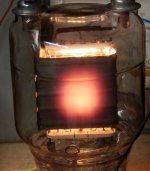 833A_maxed.jpg356.5 KB · Views: 279
833A_maxed.jpg356.5 KB · Views: 279 -
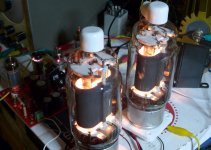 813_1_A.jpg537 KB · Views: 161
813_1_A.jpg537 KB · Views: 161
- Home
- Amplifiers
- Tubes / Valves
- tubes with the best 'glow'
